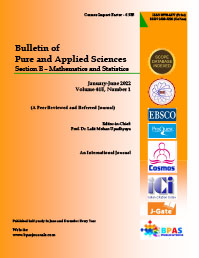Cooperative game theory approaches to manage traffic congestion in wireless networK
DOI:
https://doi.org/10.48165/Keywords:
Congestion, bandwidth, game theory, communicationAbstract
Abstract Presently more and more advanced technology enabled mobile devices are in demand and the numbers of their users are also increasing day by day. These mobile devices having so many features assembled in them demand various types of services and larger bandwidth requirements from cellular operators for their users. For satisfying the demands of their subscribers the service providers are continuously trying to introduce the newer upgraded technologies. Today the user is using so many devices having dif ferent service requirements and various capacities enabled wireless networks at the same time. Collectively all these requirements together put tremendous stress on the network traffic and this situation often leads to network congestions. Congestion is a point at which the network resources of the service provider experience stress and all services are degraded and they often collapse after some time. In the cellular network the resources are uniformly distributed but some networks are heavily loaded and others are less. So some have shortages and they need to cooperate with their adjacent neighbors, but many neighbors having their own sufficient resources are many a times not willing to cooper ative with the lesser efficient ones. To solve this issue we propose a noble cooperative approach based congestion management scheme in this paper that minimizes congestion in a network. Our prime motive is to minimize the congestion level so that the new call and handoff calls are to be served. In this schema we can reduce the congestion so that the resources are utilized effectively to satisfy the users’ demands and the qualities of services delivered are also improved.
References
Luo, J., Mukerjee, R., Dillinger, M., Mohyeldin, E. and Schulz, E. (2003). Investigation of radio resource scheduling in WLANs coupled with 3g cellular network, IEEE Comm. Magazine, 41(6), 108–115.
Pries, R., Mäder, A. and Staehle, D. (2006). A network architecture for a policy based handover across heterogeneous networks, in Proc. OPNETWORK 2006, 244–252, Washington D.C., USA, Aug 2006.
Song, W., Zhuang, W. and Cheng, Y. (2007). Load balancing for cellular/WLAN integrated networks, IEEE Network, 21(1), 27–33.
Taha, A.E.M., Hassanein, H.S. and Mouftah, H.T. (2008). Vertical handoffs as a radio resource management tool, Comput. Commun., 31(5), 950–961.
Niebert, N., Schieder, A., Abramowicz, H., Malmgren, G., Sachs, J., Horn, U., Prehofer, C. and Karl, H. (2004). Ambient networks: an architecture for communication networks beyond 3g, IEEE Wireless Communication, 11(2), 14-ff22, EU.
Dimou, K., Agero, R., Bortnik, M., Karimi, R., Koudouridis, G., Kaminski, S., Lederer, H. and Sachs, J. (2005). Generic link layer: a solution for multi-radio transmission diversity in commu nication networks beyond 3g, in Proc. IEEE 62nd Vehicular Technology Conf., Vol. 3, 1672-ff1676, Dallas, TX, USA.
Bazzi, A., Pasolini, G. and Andrisano, O. (2008). Multi radio resource management: parallel transmission for higher throughput?, EURASIP Journal on Advances in Signal Processing (JASP), Special issue entitled “Wireless Cooperative Networks”, volume 2008, Article ID 763264, 9 pages, June 2008. DOI: 10.1155/2008/763264.
Avinash Singh, A.K. Maurya, Surya Pratap Singh, Himanshu Pandey and Upendra Nath Tripathi
Niyato, D. and Hossain, E. (2006). A cooperative game framework for bandwidth allocation in 4g heterogeneous wireless networks, Proc. IEEE International Conference on Communications ICC ’06, 9, 4357–4362.
Suliman, I.M., Pomalaza-Rez, C., Lehtomki, J. and Oppermann, I. () . Radio resource allocation in heterogeneous wireless networks using cooperative games, Proc. Nordic Radio Symposium 2004 / Finnish Wireless Communications Workshop (NRS/FWCW), Oulu, Finland, 16ff18 August 2004.
